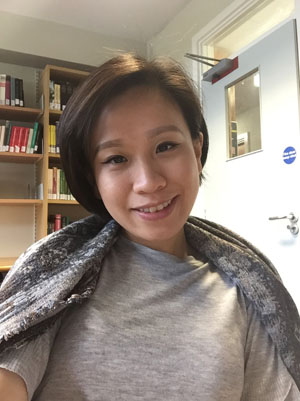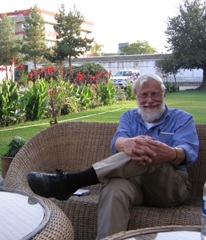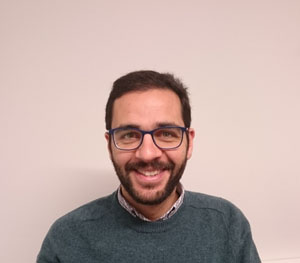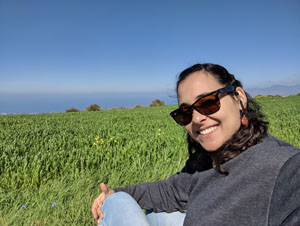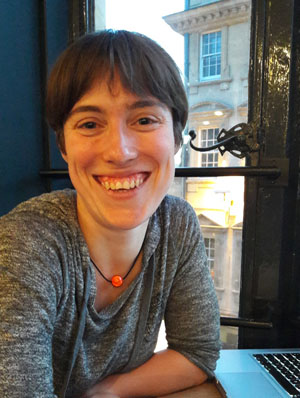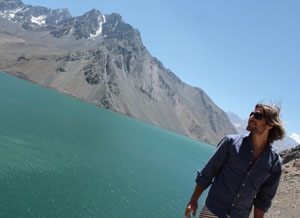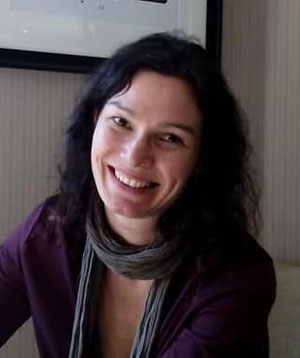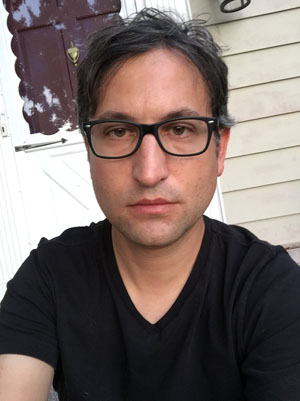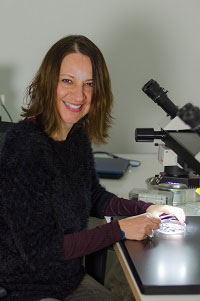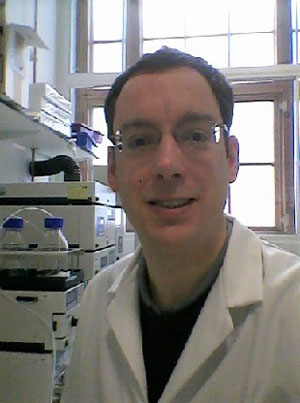Connect with us on social media
SAS Bulletin Staff
Carmen Ting, Renfrew Fellow, McDonald Institute for Archaeological Research, Univesity of Cambridge;
Carmen Ting is currently the Marie Sklodowska Curie Fellow at the Archaeological Research Unit, University of Cyprus. Her doctoral research focused on the continuities and changes in ceramic production and exchange during the 'Maya Collapse', followed by research on the ceramics from the Caribbean.
When she had had enough of rum and coke in the sun, she decided to turn her focus on the technical ceramics from Sudan (no rum but still in the sun). More recently, she has moved to yet another sunny place, i.e. Cyprus, to investigate the beginnings and development of glaze production in medieval Cyprus.
As random as her research projects appear to be, her research focus has always remained to be on ancient technologies, craft organization, and the movement of technical knowledge in past societies.
Charles KolbIndependent Scholar (retired NEH), 1005 Pruitt Court, SW, Vienna, Virginia 22180-6429, USA; tel 703-242-0063; email
Charlie Kolb holds a B.A. in History with minors in Art History and Anthropology with a focus on Latin America, the Soviet Union and South Asia) from The Pennsylvania State University and earned his Ph.D. at Penn State in Anthropology and Archaeology focusing on, Latin America and Central Asia. He did additional graduate and post-graduate coursework and directed study at Bryn Mawr College (geology), The Pennsylvania State University (geology), Argonne National Laboratory (environmental studies), Rochester Institute of Technology/Image Permanence Laboratory (still and moving images, chemistry), International Museum of Photography (imaging science), Georgia State University (audio preservation), Society of American Archivists (still images and recorded sound), Cornell University (digital imaging), National Archives and Records Administration (digital library collections management), and University of Texas-Austin (recorded sound preservation). From 1966-1989 he taught undergraduate and graduate courses in archaeology, ethnology and physical anthropology at Penn State (University Park and Erie campuses), Bryn Mawr College, and Mercyhurst University. Kolb also served as a board member of the Pennsylvania Humanities Council (1979-1989) and Director of Research and Grants at Mercyhurst where he was also assistant director of the Hammermill Library.
His archaeological and ecological field work was in Mesoamerica, Central Asia, and Northeastern North America, and East Africa. Kolb has studied ceramics since 1962 and organized and chaired 25 annual Ceramic Ecology Symposia at the American Anthropological Association meetings 1985-2011. Since 1965 he has written 6 monographs, 138 articles (102 peer-reviewed), 27 articles and book chapters (peer reviewed), 756 book reviews (print and Internet in 68 different professional publications), 14 film reviews (anthropology), 21 Internet site reviews (anthropology and history), 26 CRM reports to sponsors (archaeology), 32 technical or consultant reports (archaeology), and prepared written 63 encyclopedia contributions. He conducted CRM studies in the US for USDA Forest Service, Argonne National Laboratory, and US Department of Energy, and been honored by two festschriften.
Kolb served as senior program officer at the National Endowment for the Humanities (1989-2013). At NEH he was responsible for research and development grants and projects for preserving and providing intellectual access to still and moving image and recorded sound collections. He also worked on the National Digital Newspaper Program with the Library of Congress and advised on material culture collections (history and archaeology), environmental controls, and collections; storage and rehousing. Kolb also had responsibility for the Endowment "Recovering Iraq" and "Rediscovering Afghanistan" initiatives (2004-2011). He was a consultant for the University of Chicago’s Oriental Institute and currently for agencies of the US federal government, including ICE (antiquities assessments). His particular interests continue to be materials science - especially ceramics; archaeology, ethnology, and ethnohistory; military, naval, political, and diplomatic history; cartography; demography; and pedagogy.
Agnese Benzonelli, UCL Institute of Archaeology, 31-34 Gordon Square, London WC1H 0PY, UK, email
Agnese Benzonelli is an archaeological materials scientist at the Wolfson Archaeological Science Laboratories based at the UCL Institute of Archaeology. With a background in science and technology of cultural heritage, she applies advanced knowledge of materials science and analytical instruments to ancient and modern cultural materials as a means of addressing archaeological and conservation research questions.
Agnese has worked on projects that include the analysis of metals, glass, pigments and ceramics. Her research focuses on the investigation of metal surface treatments, the study of the colour of metals and on the development of x-ray-based techniques in archaeometry.
Artemios Oikonomou, Science and Technology in Archaeology and Culture Research Centre (STARC), The Cyprus Institute, 20 Constantinou Kavafi Street, 2121 Nicosia, Cyprus, email
Artemios Oikonomou currently holds a three-year post-doctoral research position at the Science and Technology in Archaeology and Culture Research Center (STARC) of the Cyprus Institute; the focus of this position is the investigation of glass assemblages of Late Antiquity contexts in the south east Mediterranean, including Crete and Cyprus. Prior to this position he was awarded a Marie Sklodowska Curie fellowship at the University of Nottingham, where he was investigating the continuity and change in the emergence of the Hellenistic Glass industry in Greece. Overall, his research focuses on the application of state of the art scientific techniques on the study of ancient glass as a mean for: a. the reconstruction of ancient technological aspects, b. identification of changing technological practices through space and time, c. the provenance of ancient materials, d. the integration of scientific results with key archaeological questions. On top of his research focus on glass, he is also involved in various interdisciplinary archaeological projects,both as primary researcher and research associate,identifying technologies of other materials such as pottery and frescoes.
Roxanne Radpour, Archaeomaterials Group, Materials Science and Engineering Department, University of California, Los Angeles, Los Angeles, Ca 90034, USA, email
Roxanne Radpour is a Materials Science and Engineering Ph.D. candidate in the Archaeomaterials Research Group at UCLA. She received her B.S. in Physics from the University of California, San Diego, and her M.S. in Physics from the University of Minnesota, Twin Cities. Her current research is an exploration of imaging and chemical sensing tools for archaeometry, especially for non-invasive, in situ materials characterization. These techniques range from forensic photography, portable XRF, and reflectance spectroscopy to applications of imaging spectroscopy. She is also interested in the use of novel analytical approaches and 3D visualizations to better understand the use and distribution of painting materials in ancient objects and spaces.
As a Fulbright recipient and with the support of the Cyprus American Archaeological Research Institute and the John Anson Kittredge Fund, Roxanne performed multiple field campaigns in Paphos, Cyprus to analyze archaeological wall paintings. She has also analyzed ancient funerary mummy portraits from various museum collections. These studies focus on the materials, production technologies, and practices of ancient artists to provide insight into the ancient world.
Ophélie Lebrasseur, School of Archaeology, University of Oxford, 1-2 South Parks Road, OX1 3TG, Oxford, UK, tel +44 (0) 1865 275116, email
Ophélie Lebrasseur is a postdoctoral research assistant in the School of Archaeology, University of Oxford. She is a zooarchaeologist and geneticist whose main research interest lies in the global dispersals of animals through time and their consequences on human-animal relationships and animal genetic diversity. She is particularly interested in the last 500 years with the advent of transoceanic travel, as well as South American native and introduced fauna. In addition to the Chicken Project and the Going Places project, she currently is working on the ERC’s UNDEAD project (Unifying Domestication and Evolution through Ancient DNA). She is based at the Palaeogenomics & Bioarchaeological Research Network led by Prof. Greger Larson at the University of Oxford, UK.
Chicken Project: www.scicultchickens.org
Going Places Project: http://gtr.rcuk.ac.uk/projects?ref=AH%2FP009018%2F1
UNDEAD Project: http://www.palaeobarn.com/unifying-domestication-and-evolutionary-biology-through-ancient-dna-undead
Jesse W. Tune, Department of Anthropology, Fort Lewis College, Durango, CO 81301, tel 970-247-7273, email:
Jesse Tune (Ph.D. Texas A&M University) is an Assistant Professor in the Department of Anthropology at Fort Lewis College. He specializes in Paleoindian archaeology, lithic technology, environmental archaeology, and human/environment relationships.
His research focuses on investigating the relationships between environmental change and human adaptations during the Pleistocene-to-Holocene transition.
He has led excavations at numerous Paleoindian archaeological sites, and conducted laboratory analyses of lithic assemblages from Paleoindian to Late Prehistoric archaeological periods in North America.
He uses drone-based remote sensing methodologies to document archaeological sites and assess landscape-level issues related to site formation.
Currently he is researching the early human occupation of the Colorado Plateau and human adaptations during the late Pleistocene in the Midsouth United States.
Nicolás C. Ciarlo, National Research Council of Argentina (CONICET). Ecuador 871 (C1214ACM), Autonomous City of Buenos Aires, Argentina; e-mail:
Nicolás C. Ciarlo is a maritime archaeologist, working at the Area of Research on Underwater Archaeology, Program of Historical Archaeology & Pluridisciplinary Studies, National University of Lujan (UNLu), and Teaching Assistant in Anthropology at the University of Buenos Aires (UBA), Argentina. He received his Bachelor of Archaeology (six years degree) and degree as Anthropology Teacher from the School of Philosophy & Letters, UBA. He completed his Ph.D. in archaeology at the same university with a dissertation titled ‘Technological innovation and naval conflict in Western Europe, 1751-1815: archaeological and historical contributions to the knowledge of metallurgy and their applications on warships’.
He also completed additional post-graduate coursework in epistemology and history of science at the Tres de Febrero University. During these years, he was supported by the National Research Council of Argentina (CONICET) and received awards from the Advisory Council on Underwater Archaeology and the Society for Archaeological Sciences for the research conducted with metals artifacts from mid 18th to early 19th century shipwrecks. After his doctorate, he received a Postdoctoral Scholarship from the CONICET to analyze the cargo of a British ship from the Napoleonic Wars sunk in Catalonia, Spain.
Since 2004 he has conducted studies on metal artifacts from historical shipwrecks at the Archaeometallurgy Group of the School of Engeneering, UBA, where he also performed as Teaching Assistant of the ‘Metallography for Archaeological Materials’ graduate course. He has also taught courses in historical and maritime archaeology and co-organized national scientific meetings in archaeometry. Dr. Ciarlo’s main research interest is the relationship between technological innovation, naval conflicts and science during the beginnings of industrialization in Europe, with focus on metallurgy. More information on his research publications can be found at: https://conicet.academia.edu/NicolásCiarlo
Apostolos Sarris, Laboratory of Geophysical - Satellite Remote Sensing & Archaeoenvironment, Institute of Mediterranean Studies, Foundation of Research & Technology Hellas, Melissinou & Nikiforou Foka 130, P.O. Box 119, Rethymnon 74100, Crete, Greece; tel (30)-831-25146, (30)-831-56627; fax (30)-831-25810; e-mail:
Born in Chania, Crete, Greece in 1963. He received a B.A. in Astronomy & Physics (1985) and M.A. in Physics (1988) at Boston University (1985) and a M.Sc. (1990) and a Ph.D. in Physics (1992) at the University of Nebraska-Lincoln. Since then he became active in education and research, being a contracted lecturer at the University of Maryland (European Division), the National Hellenic Airforce Academy, the University of Crete, the Technological Educational Institute of Crete and the Aristotelian University of Thessaloniki.
Currently he is a researcher at the Institute for Mediterranean Studies - FORTH and director of the Laboratory of Geophysical and Satellite Remote Sensing & Archaeo-environment. The Lab is part of the Association of Geographic Information Laboratories of Europe (AGILE) and of EPOCH consortium. His research interests span from Applied Geophysics and Remote Sensing to Geophysical Prospection of Archaeological Sites, Site Assessment and Modelling through the Application of Remote Sensing/GIS techniques, Satellite Remote Sensing, Image Processing, Classification techniques and Environmental Research-Development Strategies. Until now he has organized, planned and participated in more than 100 geophysical/satellite remote sensing/GIS/GPS projects in Greece, U.S.A., Cyprus, Hungary, Albania, and Egypt. He has written 4 chapters in books, 1 Proceedings Volume, 34 refereed journal papers, 48 refereed papers in books of proceedings, 12 in non-refereed journals, 70 Technical Reports, 3 Technical Guides/Notes.
He is acting as an Assistant National representative in the Scientific Committee for Peace and Safety of Safety of ΝΑΤΟ (ΝΑΤΟ/Committee on Science for Peace and Security/SPS) (2006-2010), vice-chair of the International Society for Archaeological Prospection (ISAP), and associate editor of the Society for Archaeological Sciences Bulletin and of Archaeological Prospection Journal.
Laerke Recht: McDonald Institute for Archaeological Research, University of Cambridge, Downing Street, CB2 3DZ, UK; email
Laerke Recht is an archaeologist whose research focuses on the archaeology of the Bronze Age eastern Mediterranean and Near East. She is particularly interested in the themes of interaction between the regions of the eastern Mediterranean, religion, gender and human-animal relations in the past and our modern interpretation of these interactions. She has most recently finished a Marie Sklodowska-Curie Fellowship at University of Cambridge on the project entitled ‘The Spirited Horse: Human-equid relations in the Bronze Age Near East’. This project involves examining different species of equids and their identification in the zooarchaeological, icnonographic, and epigraphic records. Lareke also works on the Hala Sultan Tekke project in Cyprus (Aegean ceramics and animals), and on the Tell Mozan/Urkesh project in Syria (ceramics, glyptics, digital publication).
Mark Golitko: Department of Anthropology, University of Notre Dame, 296 Corbett Family Hall, Notre Dame, IN 46556, USA: email
Mark Golitko is an Assistant Professor of Anthropology at the University of Notre Dame (Notre Dame, Indiana). Prior to that, he worked as a postdoctoral researcher at the Field Museum of Natural History in Chicago. He received his BSc in History from the University of Wisconsin- Madison, and an MS and PhD in Anthropology from the University of Illinois at Chicago. He currently conducts fieldwork in Papua New Guinea and SE Europe. He has worked extensively with ICP-MS-pXRF, SEM-EDS, and petrographic analyses of ceramics and lithics materials from Europe, the Americas, and the SW Pacific, both at the Field Museum Elemental Analysis Facility (EAF) and now as the director of the Notre Dame Archaeological X-ray Laboratory (NDAXL). He is particularly interested in using geochemical data and computational approaches including GIS and network analysis to analyze prehistoric social networks and their role in patterning biocultural diversity.
Evi Margaritis: Evi Margaritis, STARC, The Cyprus Institute, 20 Constantinou Kavafi Street, 2121 Nicosia, Cyprus; email
Evi Margaritis is a leading expert in archaeobotanical research in the east Mediterranean and the only archaeobotantist based in Cyprus, where she is an assistant professor at the Science and Technology in Archaeology and Culture Research Centre of the Cyprus Institute. Her research focuses on exploring the human-environment relationship in the Aegean and eastern Mediterranean through botanical remains and environmental evidence. Her research projects stretch from the Minoan and Mycenaean agriculture to early Bronze Age farming, and Classical economy. Currently, she is the assistant director of the Cambridge Keros Project, where she is in charge of all environmental studies of the project and organised several field school to train the next generation of archaeologists in the eastern Mediterranean region.
Thibaut Devièse: University of Oxford, 1 South Parks Road, OX1 3TG, UK, email
Thibaut Devièse is researcher at the University of Oxford in the Oxford Radiocarbon Accelerator Unit. He is an analytical chemist by training. After a PhD in collaboration between the University of Pisa (Italy) and the University Pierre et Marie Curie (Paris), he worked for 5 years in the Scientific department of the British Museum where he conducted his research on the characterisation of organic materials present is objects of the collection, focusing particularly on organic residues in ceramics and on natural organic colorants in textiles. In 2014, he joined the University of Oxford where he focuses his research on the development and application of new analytical methods for the characterisation and compound-specific radiocarbon dating of organic materials from archaeological and environmental contexts. The application of these methods to Palaeolithic bones is helping in improving our understanding of human dispersals in Eurasia during the Palaeolithic and extinction of animal species. View my Publications

